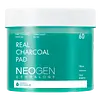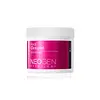What's inside
What's inside
 Key Ingredients
Key Ingredients

 Benefits
Benefits

 Concerns
Concerns

No concerns
 Ingredients Side-by-side
Ingredients Side-by-side

Water
Skin ConditioningPropanediol
Solvent1,2-Hexanediol
Skin ConditioningBetaine
HumectantTrehalose
HumectantOctyldodeceth-16
EmulsifyingEthylhexylglycerin
Skin ConditioningGardenia Florida Fruit Extract
Skin ConditioningCitrus Aurantium Dulcis Peel Oil
MaskingDextrin
AbsorbentCitrus Aurantium Bergamia Fruit Oil
MaskingTheobroma Cacao Extract
Skin ConditioningMaltodextrin
AbsorbentButylene Glycol
HumectantLavandula Angustifolia Oil
MaskingGuaiazulene
AntimicrobialGluconolactone
Skin ConditioningGlutathione
Charcoal Powder
AbrasiveAdenosine
Skin ConditioningAlgin
MaskingEucalyptus Globulus Leaf Oil
PerfumingKaolin
AbrasiveCaffeine
Skin ConditioningCalamine
AbsorbentCanadian Colloidal Clay
Skin ConditioningChamaecyparis Obtusa Oil
MaskingCapryloyl Salicylic Acid
ExfoliatingButyl Avocadate
Skin ConditioningLitsea Cubeba Fruit Oil
MaskingCyanocobalamin
Skin ConditioningGlycerin
HumectantPelargonium Graveolens Oil
MaskingOcimum Basilicum Oil
MaskingSilt
AbsorbentOenothera Biennis Flower Extract
AstringentPinus Palustris Leaf Extract
TonicUlmus Davidiana Root Extract
Skin ConditioningPueraria Lobata Root Extract
HumectantMentha Piperita Leaf Extract
Skin ConditioningZingiber Officinale Root Extract
MaskingHydrolyzed Collagen
EmollientAcacia Senegal Gum
MaskingLeuconostoc/Radish Root Ferment Filtrate
AntimicrobialPropolis Extract
Skin ConditioningPortulaca Oleracea Extract
Skin ConditioningSodium Hyaluronate
HumectantCollagen
MoisturisingPalmitoyl Tripeptide-5
Skin ConditioningCaprylyl Glycol
EmollientPeat Water
Skin ConditioningEnteromorpha Compressa Extract
Skin ProtectingLaminaria Japonica Extract
Skin ProtectingSpirulina Platensis Extract
Skin ProtectingGelidium Cartilagineum Extract
Skin ProtectingUndaria Pinnatifida Extract
Skin ConditioningCitric Acid
BufferingHydroxypropyl Methylcellulose
Emulsion StabilisingRutin
AntioxidantHydroxycinnamic Acid
Skin ConditioningPentylene Glycol
Skin ConditioningHydroxypropyltrimonium Hyaluronate
Acetyl Hexapeptide-8
HumectantTriticum Vulgare Sprout Extract
Skin ConditioningMoringa Oleifera Seed Extract
Skin ConditioningPropyl Gallate
AntioxidantCitrus Aurantifolia Fruit Extract
Skin ConditioningMelaleuca Alternifolia Leaf Extract
PerfumingHydrolyzed Hyaluronic Acid
HumectantOligopeptide-1
Skin ConditioningSodium Acetylated Hyaluronate
HumectantPotassium Sorbate
PreservativePalmitoyl Pentapeptide-4
Skin ConditioningSodium Hyaluronate Crosspolymer
HumectantAlginic Acid
Skin ConditioningLimonene
PerfumingLinalool
PerfumingWater, Propanediol, 1,2-Hexanediol, Betaine, Trehalose, Octyldodeceth-16, Ethylhexylglycerin, Gardenia Florida Fruit Extract, Citrus Aurantium Dulcis Peel Oil, Dextrin, Citrus Aurantium Bergamia Fruit Oil, Theobroma Cacao Extract, Maltodextrin, Butylene Glycol, Lavandula Angustifolia Oil, Guaiazulene, Gluconolactone, Glutathione, Charcoal Powder, Adenosine, Algin, Eucalyptus Globulus Leaf Oil, Kaolin, Caffeine, Calamine, Canadian Colloidal Clay, Chamaecyparis Obtusa Oil, Capryloyl Salicylic Acid, Butyl Avocadate, Litsea Cubeba Fruit Oil, Cyanocobalamin, Glycerin, Pelargonium Graveolens Oil, Ocimum Basilicum Oil, Silt, Oenothera Biennis Flower Extract, Pinus Palustris Leaf Extract, Ulmus Davidiana Root Extract, Pueraria Lobata Root Extract, Mentha Piperita Leaf Extract, Zingiber Officinale Root Extract, Hydrolyzed Collagen, Acacia Senegal Gum, Leuconostoc/Radish Root Ferment Filtrate, Propolis Extract, Portulaca Oleracea Extract, Sodium Hyaluronate, Collagen, Palmitoyl Tripeptide-5, Caprylyl Glycol, Peat Water, Enteromorpha Compressa Extract, Laminaria Japonica Extract, Spirulina Platensis Extract, Gelidium Cartilagineum Extract, Undaria Pinnatifida Extract, Citric Acid, Hydroxypropyl Methylcellulose, Rutin, Hydroxycinnamic Acid, Pentylene Glycol, Hydroxypropyltrimonium Hyaluronate, Acetyl Hexapeptide-8, Triticum Vulgare Sprout Extract, Moringa Oleifera Seed Extract, Propyl Gallate, Citrus Aurantifolia Fruit Extract, Melaleuca Alternifolia Leaf Extract, Hydrolyzed Hyaluronic Acid, Oligopeptide-1, Sodium Acetylated Hyaluronate, Potassium Sorbate, Palmitoyl Pentapeptide-4, Sodium Hyaluronate Crosspolymer, Alginic Acid, Limonene, Linalool
Water
Skin ConditioningGlycerin
HumectantButylene Glycol
HumectantCentella Asiatica Extract
CleansingDipropylene Glycol
Humectant1,2-Hexanediol
Skin ConditioningAsiaticoside
AntioxidantAsiatic Acid
Skin ConditioningMadecassic Acid
Skin ConditioningMadecassoside
AntioxidantLactobionic Acid
BufferingGluconolactone
Skin ConditioningHyaluronic Acid
HumectantHydrolyzed Hyaluronic Acid
HumectantSodium Hyaluronate
HumectantOctyldodecanol
EmollientCeramide NP
Skin ConditioningHydrogenated Lecithin
EmulsifyingCaprylic/Capric Triglyceride
MaskingAllantoin
Skin ConditioningBetaine
HumectantPanthenol
Skin ConditioningCetearyl Olivate
Sorbitan Olivate
EmulsifyingGlyceryl Caprylate
EmollientEthylhexylglycerin
Skin ConditioningTromethamine
BufferingAcrylates/C10-30 Alkyl Acrylate Crosspolymer
Emulsion StabilisingXanthan Gum
EmulsifyingPropanediol
SolventDiglycerin
HumectantCitrus Aurantium Bergamia Fruit Oil
MaskingDisodium EDTA
Water, Glycerin, Butylene Glycol, Centella Asiatica Extract, Dipropylene Glycol, 1,2-Hexanediol, Asiaticoside, Asiatic Acid, Madecassic Acid, Madecassoside, Lactobionic Acid, Gluconolactone, Hyaluronic Acid, Hydrolyzed Hyaluronic Acid, Sodium Hyaluronate, Octyldodecanol, Ceramide NP, Hydrogenated Lecithin, Caprylic/Capric Triglyceride, Allantoin, Betaine, Panthenol, Cetearyl Olivate, Sorbitan Olivate, Glyceryl Caprylate, Ethylhexylglycerin, Tromethamine, Acrylates/C10-30 Alkyl Acrylate Crosspolymer, Xanthan Gum, Propanediol, Diglycerin, Citrus Aurantium Bergamia Fruit Oil, Disodium EDTA
Ingredients Explained
These ingredients are found in both products.
Ingredients higher up in an ingredient list are typically present in a larger amount.
1,2-Hexanediol is a synthetic liquid and another multi-functional powerhouse.
It is a:
- Humectant, drawing moisture into the skin
- Emollient, helping to soften skin
- Solvent, dispersing and stabilizing formulas
- Preservative booster, enhancing the antimicrobial activity of other preservatives
Betaine is a common humectant (a substance that promotes retention of moisture). It's known to be gentle on the skin and can help balance hydration.
This ingredient is best for improving hydration and soothing irritated skin. Studies also show it helps even out skin tone.
Fun fact: Betaine is naturally created in the skin and body. The kind found within cosmetic products can be either plant-derived or synthetic.
Another name for betaine is trimethylglycine.
Learn more about BetaineButylene Glycol (or BG) is used within cosmetic products for a few different reasons:
Overall, Butylene Glycol is a safe and well-rounded ingredient that works well with other ingredients.
Though this ingredient works well with most skin types, some people with sensitive skin may experience a reaction such as allergic rashes, closed comedones, or itchiness.
Learn more about Butylene GlycolCitrus Aurantium Bergamia Fruit Oil is the oil from the bergamot orange. It is native to Italy.
This ingredient is used to add fragrance to products. It contains limonene, linalool, and linalyl acetate.
The term 'fragrance' is not regulated in many countries. In many cases, it is up to the brand to define this term. For instance, many brands choose to label themselves as "fragrance-free" because they are not using synthetic fragrances. However, their products may still contain ingredients such as essential oils that are considered a fragrance.
When used topically, Citrus Aurantium Bergamia Fruit Oil is a photosensitizer due to its furanocoumarins. Photosensitizers make the skin and eyes much more sensitive to sunlight. Photosensitizers are linked to skin cancer.
However, more cosmetics using Citrus Aurantium Bergamia Fruit Oil are removing the furanocoumarins.
Bergamot oil was also found to have anti-inflammatory, antibacterial and antifungal properties.
Learn more about Citrus Aurantium Bergamia Fruit OilEthylhexylglycerin (we can't pronounce this either) is commonly used as a preservative and skin softener. It is derived from glyceryl.
You might see Ethylhexylglycerin often paired with other preservatives such as phenoxyethanol. Ethylhexylglycerin has been found to increase the effectiveness of these other preservatives.
Gluconolactone is a PHA. PHAs are a great gentle alternative to traditional AHAs.
When applied, Gluconolactone has the same affect on skin as AHAs such as lactic acid. It helps dissolve the dead skin cells in the top layer of your skin. This improves texture and brightens the skin.
PHAs are more gentle than AHAs due to their larger structure. They do not penetrate as deeply as AHAs and take a longer time to dissolve dead cells. Studies show PHAs do not cause as much irritation.
Gluconolactone has some interesting properties:
In a 2004 study, Gluconolactone was found to prevent UV damage in mouse skin cells and has not been found to increase sun sensitivity. However, we still recommend wearing SPF daily.
This ingredient is is an created by reacting gluconic acid with an alcohol.
Learn more about GluconolactoneGlycerin is already naturally found in your skin. It helps moisturize and protect your skin.
A study from 2016 found glycerin to be more effective as a humectant than AHAs and hyaluronic acid.
As a humectant, it helps the skin stay hydrated by pulling moisture to your skin. The low molecular weight of glycerin allows it to pull moisture into the deeper layers of your skin.
Hydrated skin improves your skin barrier; Your skin barrier helps protect against irritants and bacteria.
Glycerin has also been found to have antimicrobial and antiviral properties. Due to these properties, glycerin is often used in wound and burn treatments.
In cosmetics, glycerin is usually derived from plants such as soybean or palm. However, it can also be sourced from animals, such as tallow or animal fat.
This ingredient is organic, colorless, odorless, and non-toxic.
Glycerin is the name for this ingredient in American English. British English uses Glycerol/Glycerine.
Learn more about GlycerinHydrolyzed Hyaluronic Acid is a form of hyaluronic acid. It is created by the hydrolysis of hyaluronic acid with a high molecular weight. Once created, Hydrolyzed Hyaluronic Acid has a low molecular weight.
Low molecular weight HA has been shown to hydrate and increase elasticity of the skin. Increasing elasticity is also associated with reduction of wrinkle depth.
One study found topical low molecular weight hyaluronic acid may be considered for the treatment of rosacea in the adult population. However, we always recommend speaking with a professional about your skin concerns.
Hyaluronic acids are a humectant. This means they draw moisture from the air. Hyaluronic acids help moisturize, soothe, and protect the skin.
Read more about other common forms of hyaluronic acid:
Learn more about Hydrolyzed Hyaluronic AcidPropanediol is an all-star ingredient. It softens, hydrates, and smooths the skin.
It’s often used to:
Propanediol is not likely to cause sensitivity and considered safe to use. It is derived from corn or petroleum with a clear color and no scent.
Learn more about PropanediolSodium Hyaluronate is hyaluronic acid's salt form. It is commonly derived from the sodium salt of hyaluronic acid.
Like hyaluronic acid, it is great at holding water and acts as a humectant. This makes it a great skin hydrating ingredient.
Sodium Hyaluronate is naturally occurring in our bodies and is mostly found in eye fluid and joints.
These are some other common types of Hyaluronic Acid:
Learn more about Sodium HyaluronateWater. It's the most common cosmetic ingredient of all. You'll usually see it at the top of ingredient lists, meaning that it makes up the largest part of the product.
So why is it so popular? Water most often acts as a solvent - this means that it helps dissolve other ingredients into the formulation.
You'll also recognize water as that liquid we all need to stay alive. If you see this, drink a glass of water. Stay hydrated!
Learn more about Water